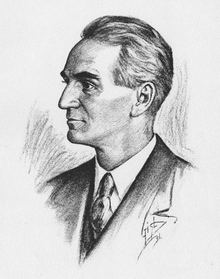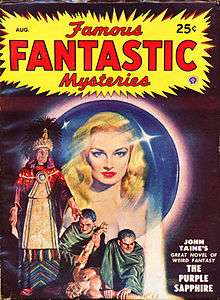Eric Temple Bell
Eric Temple Bell (February 7, 1883 – December 21, 1960) was a Scottish-born mathematician and science fiction writer who lived in the United States for most of his life. He published non-fiction using his given name and fiction as John Taine.
Eric Temple Bell | |
|---|---|
 1931 drawing of Eric Temple Bell | |
| Born | February 7, 1883 Peterhead, Scotland, UK |
| Died | December 21, 1960 (aged 77) |
| Nationality | British |
| Alma mater | Stanford University Columbia University (Ph.D.) |
| Known for | Number theory Bell series Bell polynomials Bell numbers Bell triangle Ordered Bell numbers |
| Awards | Bôcher Memorial Prize (1924) |
| Scientific career | |
| Fields | Mathematics |
| Institutions | University of Washington California Institute of Technology |
| Doctoral advisor | Frank Nelson Cole Cassius Keyser |
| Doctoral students | Howard Percy Robertson Morgan Ward Zhou Peiyuan |
Biography
Bell was born in Peterhead, Aberdeen, Scotland, but his father, a factor, relocated to San Jose, California in 1884, when he was fifteen months old. The family returned to Bedford, England after his father's death, on January 4, 1896. Bell returned to the United States by way of Montreal in 1902.
Bell was educated at Bedford Modern School, where his teacher Edward Mann Langley inspired him to continue the study of mathematics, Stanford University, the University of Washington, and Columbia University[1] (where he was a student of Cassius Jackson Keyser). He was part of the faculty first at the University of Washington and later at the California Institute of Technology.
He researched number theory; see in particular Bell series. He attempted—not altogether successfully—to make the traditional umbral calculus (understood at that time to be the same thing as the "symbolic method" of Blissard) logically rigorous. He also did much work using generating functions, treated as formal power series, without concern for convergence. He is the eponym of the Bell polynomials and the Bell numbers of combinatorics. In 1924 he was awarded the Bôcher Memorial Prize for his work in mathematical analysis. He died in 1960 in Watsonville, California.
Fiction and poetry
During the early 1920s, Bell wrote several long poems. He also wrote several science fiction novels, which independently invented some of the earliest devices and ideas of science fiction.[2] Only the novel The Purple Sapphire was published at the time, using the pseudonym John Taine; this was before Hugo Gernsback and the genre publication of science fiction. His novels were published later, both in book form and serialized in magazines. Basil Davenport, writing in The New York Times, described Taine as "one of the first real scientists to write science-fiction [who] did much to bring it out of the interplanetary cops-and-robbers stage." But he concluded that "[Taine] is sadly lacking as a novelist, in style and especially in characterization."[3]
Writing about mathematics
Bell wrote a book of biographical essays titled Men of Mathematics (one chapter of which was the first popular account of the 19th century woman mathematician Sofia Kovalevskaya), which is still in print. The book inspired notable mathematicians including Julia Robinson,[4] John Forbes Nash, Jr.,[5] and Andrew Wiles[6] to begin a career in mathematics. However, historians of mathematics have disputed the accuracy of much of Bell's history. In fact, Bell does not distinguish carefully between anecdote and history. He has been much criticized for romanticizing Évariste Galois. For example: "[E. T.] Bell's account [of Galois's life], by far the most famous, is also the most fictitious."[7] His treatment of Georg Cantor, which reduced Cantor's relationships with his father and with Leopold Kronecker to stereotypes, has been criticized even more severely.[8]
Bell's later book Development of Mathematics has been less famous, but his biographer Constance Reid finds it has fewer weaknesses.[9] His book on Fermat's Last Theorem, The Last Problem, was published the year after his death and is a hybrid of social history and the history of mathematics.[10]
Works
Non-fiction books
- An Arithmetical Theory of Certain Numerical Functions, Seattle Washington, The University, 1915, 50p. PDF/DjVu copy from Internet Archive.
- The Cyclotomic Quinary Quintic, Lancaster, Pennsylvania, The New Era Printing Company, 1912, 97p.
- Algebraic Arithmetic, New York, American Mathematical Society, 1927, 180p.
- Debunking Science, Seattle, University of Washington book store, 1930, 40p.
- The Queen of the Sciences, Stechert, 1931, 138p.
- Numerology, Baltimore: The Williams & Wilkins Co., 1933, 187p. LCCN 33-6808
- Reprint: Westport, CT: Hyperion Press, 1979, ISBN 0-88355-774-6, 187p. – "Reprint of the ed. published by Century Co., New York" LCCN 78-13855
- The Search for Truth, Baltimore, Reynal and Hitchcock, 1934, 279p.
- Reprint: Williams and Wilkins Co, 1935
- The Handmaiden of the Sciences, Williams & Wilkins, 1937, 216p.
- Man and His Lifebelts, New York, Reynal & Hitchcock, 1938, 340p.
- Reprint: George Allen & Unwin Ltd., 1935, 2nd printing 1946
- Reprint: Kessinger Publishing, 2005
- Men of Mathematics, New York, Simon & Schuster, 1937, 592p.
- Reprint: Touchstone (Simon & Schuster paperback), 1986. ISBN 0671628186 LCCN 86-10229
- The Development of Mathematics, New York, McGraw–Hill, 1940, 637p.
- Second Edition: New York, McGraw–Hill, 1945, 637p.
- Reprint: Dover Publications, 1992
- The Magic of Numbers, Whittlesey House, 1946, 418p.
- Reprint: New York, Dover Publications, 1991, ISBN 0-486-26788-1, 418p.
- Reprint: Sacred Science Institute, 2006
- Mathematics: Queen and Servant of Science, McGraw-Hill, 1951, 437p.
- The Last Problem, New York, Simon & Schuster, 1961, 308p.
- Reprint: Mathematical Association of America, 1990, ISBN 0-88385-451-1, 326p.
Scholarly papers
- "Arithmetical paraphrases". In: Transactions of the American Mathematical Society 22, 1921, pp. 1–30 and 198–219
- "Arithmetical equivalents for a remarkable identity between theta functions". In: Mathematische Zeitschrift 13, 1922, pp. 146–152
- "Existence theorems on the numbers of representations of odd integers as sums of 4t + 2 squares". In: Crelles Journal 163, 1930, pp. 65–70
- "Exponential numbers". In: The American Mathematical Monthly 41, 1934, pp. 411–419
Novels

- The Purple Sapphire (1924)
- The Gold Tooth (1927)
- Quayle's Invention (1927)
- Green Fire (1928)
- The Greatest Adventure (1929)
- The Iron Star (1930)
- The White Lily (1930)
- The Time Stream (1931)
- Seeds of Life (1931)
- Before the Dawn (1934)
- Tomorrow (1939)
- The Forbidden Garden (1947)
- The Cosmic Geoids and One Other (1949)
- The Crystal Horde (1952)
- G.O.G. 666 (1954)
Poetry
- The Singer (1916)
Quotes
- "Obvious is the most dangerous word in mathematics."[11]
References
- Goodstein, Judith R.; Babbitt, Donald (June–July 2013), "E.T. Bell and Mathematics at Caltech between the Wars" (PDF), Notices of the American Mathematical Society, 60 (6): 688, doi:10.1090/noti1009, retrieved 30 June 2013
- Reid, Constance (1993), The Search for E.T. Bell, MAA spectrum, The Mathematical Association of America, p. 253,
Most fiction writers are, after all, primarily fiction writers", he [Glenn Hughes, professor of English literature] wrote of Bell. "Some of them may show a trifle more finesse in plot handling or characterization, but none of them surpasses Bell in grandness of conception or accuracy of detail. One has always the uncanny feeling that [he] is dealing in probabilities, and that many of his most extravagant dreams are but pre-visions of nightmares in store for the human race.
- Davenport, Basil (October 19, 1952), "Spacemen's Realm", The New York Times.
- Reid, Constance (1996), Julia, a Life in Mathematics, MAA spectrum, Cambridge University Press, p. 25, ISBN 9780883855201,
The only idea of real mathematics that I had came from Men of Mathematics. In it I got my first glimpse of a mathematician per se. I cannot overemphasize the importance of such books about mathematics in the intellectual life of a student like myself completely out of contact with research mathematicians.
- Kuhn, Harold W.; Nasar, Sylvia (2002), The Essential John Nash, Princeton University Press, p. 6, ISBN 9780691095271,
By the time I was a student in high school I was reading the classic "Men of Mathematics" by E. T. Bell and I remember succeeding in proving the classic Fermat theorem about an integer multiplied by itself p times where p is a prime.
- Hodgkin, Luke (2005), A History of Mathematics: From Mesopotamia to Modernity, Oxford University Press, p. 254, ISBN 9780191664366,
The fact that Wiles was stimulated in childhood by E. T. Bell's romantic personalized anecdotal book Men of Mathematics to nurse an ambition to solve the problem Fermat's Last Theorem is in itself an index of the power which a certain view of the history of mathematics can exercise.
- Rothman (1982), 103.
- See chiefly Grattan-Guinness, Ivor (1971), "Towards a Biography of Georg Cantor", Annals of Science 27: 345–91.
- The Search for E.T. Bell, p. 307,
The Development of Mathematics still strikes [topologist Albert W.] Tucker - among books on the history of mathematics - 'as the most interesting as far as I am concerned.' Unlike Men of Mathematics, which he finds 'almost fiction,' The Development of Mathematics was intended for an essentially professional audience.
- The Search for E.T. Bell, p. 352,
Thirty years later it [The Last Problem] was reissued by the Mathematical Association of America with an introduction by Underwood Dudley - who had some difficulty in describing it. 'It is not a book of mathematics. Pages go by without an equation appearing, and in mathematics books you are not told such things as that the ancient Spartans were "as virile as gorillas and as hard (including their heads) as bricks"...It is an unusual book.' Dudley concluded - as unusual as the man who had written it.
- Beck, Matthias; Marchesi, Gerald; Pixton, Dennis; Sabalka, Lucas (2002–2012), A First Course in Complex Analysis (PDF), p. 26.
- Sources
- Reid, Constance (1993). The Search for E. T. Bell, Also Known as John Taine. Washington, DC: Mathematical Association of America. x + 372 pp. ISBN 0-88385-508-9. OCLC 29190602.
- Rothman, T. (1982). "Genius and biographers: the fictionalization of Evariste Galois". American Mathematics Monthly 89, no. 2, 84–106.
- Further reading
- Tuck, Donald H. (1974). The Encyclopedia of Science Fiction and Fantasy. Chicago: Advent. p. 36. ISBN 0-911682-20-1.
External links
| Wikiquote has quotations related to: Eric Temple Bell |
- Biographical sketch by Constance Reid
- O'Connor, John J.; Robertson, Edmund F., "Eric Temple Bell", MacTutor History of Mathematics archive, University of St Andrews.
- Eric Temple Bell at the Mathematics Genealogy Project
- Works by Eric Temple Bell at Faded Page (Canada)
- MAA presidents: Eric Temple
- John Taine at the Internet Speculative Fiction Database
- John Taine at Library of Congress Authorities, with 26 catalog records (distinct from Bell)
- Eric Temple Bell at Library of Congress Authorities, with 26 catalog records (distinct from Taine)
- Author profile in the database zbMATH